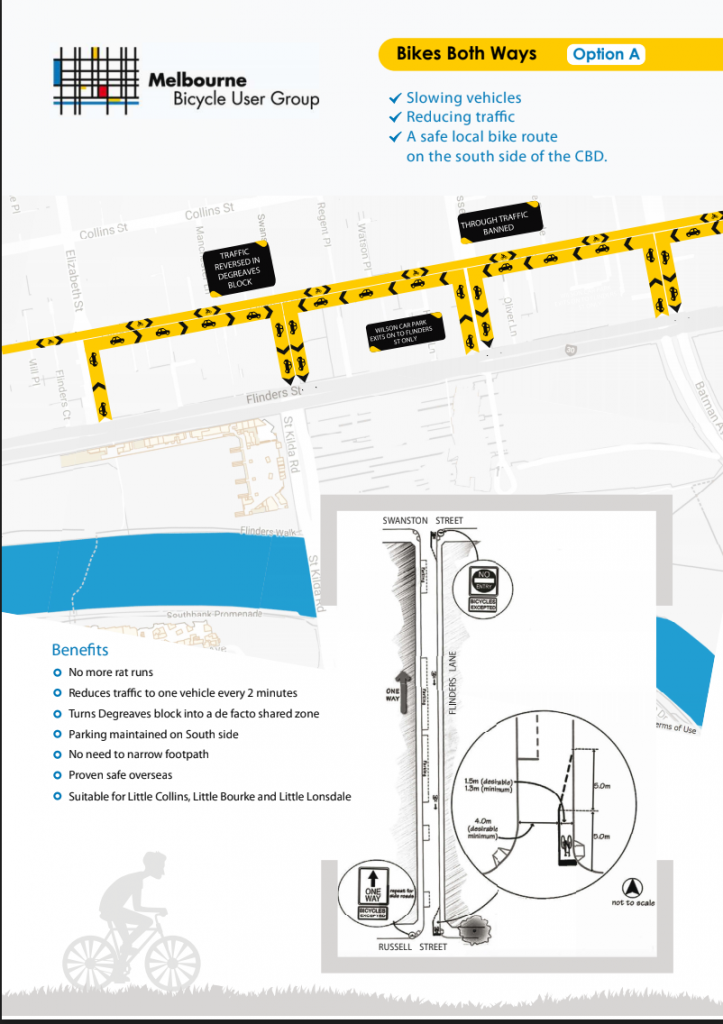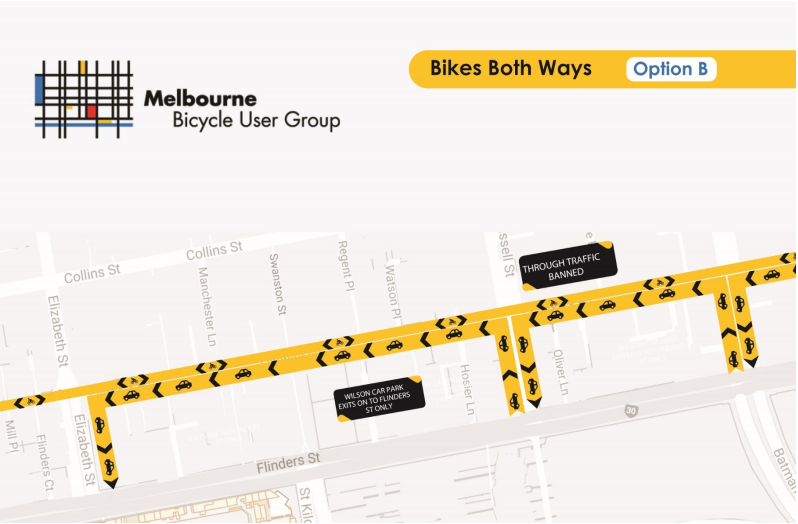At these elections there are two tickets with an outstanding track record of supporting and achieving outcomes for bikes. These are The Greens and Team Sally Capp. Here we present what we know about the candidates in relation to getting more people riding bikes.
Continue reading »The Amy Gillett Foundation released its big coronavirus related campaign to get more bike lanes built in Australia yesterday. A lot of businesses signed on to the campaign, which shows just how many hard-working people support the foundation and its mission. But the AGF is starved of cash, undemocratic, and is now duplicating others’ work. It’s time for the foundation to close down and for its members to work with the rest of the cycling community towards its laudable goals.
Continue reading »There’s been a lot of talk on Facebook and Twitter about a new protected intersection currently being installed on Albert Street in East Melbourne. The protected intersection was funded through the $100m TAC Safer Cycling and Pedestrian fund, promised by the Andrews government before the 2014 election. Many of the projects on the list have been delayed significantly, and there is concern some of the money has been diverted to non-cycling related projects, so it’s fantastic to see something finally being built!
Continue reading »Belated upate 27/11/2019. On May 19th 2019, Cr Leppert moved “That the Future Melbourne Committee notes the outcome of the study and recommends that Council endorses installation of continuous protected full time bicycle lanes in Exhibition Street in its adoption of the 2019-20 budget.” In priniple there should be no unprotected sections, and the City’s current policy is to run protection up to the stop line, no more skinny lanes at the intersection. The project requires no further Council approval.
Continue reading »The glossy documents claim that “Fishermans Bend [will be] an exceptional place to cycle”. However the proposed network relies on eight new bridges which are unfunded. See Fishermens Bend Framework (PDF). These bridges will also have uphill grades to climb.
Continue reading »Submission On behalf of Melbourne Bicycle User Group
Continue reading »Victorian Cycling Groups are getting together to discuss coordination and goals for this year’s State election. If your group hasn’t been contacted yet, please get in touch via our Contact Us page or register via https://www.eventbrite.com.au/e/cyclists-get-organised-for-the-2018-victorian-state-election-tickets-48150575668 to let us know you are coming.
The meeting will be from 5:30 to 8:00 PM on Tuesday August 7th at Maurice Blackburn, 380 LaTrobe St, Melbourne.
With both of the major parties giving little thought and less funding to safe bicycle infrastructure, what can we do? Come along with your ideas and goals.
The Masterplan
St Kilda Rd is divided along most of its length between City of Port Phillip (CoPP) and City of Melbourne (CoM). St. Kilda Road is the main commuter route for people who ride bikes from the south eastern suburbs into the city, with over 3000 cyclists per day. It is the second most dangerous street for cyclists in Melbourne, with 174 crashes between 2006 and 2015. There is a narrow bicycle lane, with ‘car dooring’ a major concern on this route.
For about 10 years now a masterplan has been in preparation by CoM, CoPP has been working hard to get safe bike lanes and VicRoads has done the preparatory work to make it happen.
History
Current St Kilda Rd bikelanes: 
The masterplan has never reached the stage of a draft for public comment, but has always included protected bike lanes. About eight years ago, this was leaked to the media who door-stopped the then roads minister (now treasurer of Victoria) Tim Pallas about the idea. His off-the-cuff reaction was to reject safe bikelanes in favour of “easing congestion” for cars. The masterplan then gathered dust for about four years before the Balieu Government was elected in 2010 and indicated they were willing to take a fresh look at St Kilda Rd. City of Port Phillip, City of Melbourne and Local liberal member Clem Newtown-Brown pushed hard for safe bicycle lanes on St Kilda Road.
After forming government in 2014 Labor promised to investigate protected bicycle lanes. During construction of the Domain Station, motor traffic in St Kilda Road is constrained, creating a once in a lifetime opportunity to construct safe bike lanes while traffic levels are low. VicRoads spent six months and over $300,000 investigating options for protected bicycle lanes. The study outcomes haven’t been released but Vicroads has looked at protected lanes in the centre of St Kilda Rd, adjacent to the tram tracks. This time it was the Premier who was asked on talkback radio and replied “we won’t be having any of that”. Although the project hasn’t been officially cancelled, the Premier’s comment makes progress unlikely. City of Port Phillip stated http://www.portphillip.vic.gov.au/apr-2017-media_6957.htm that they would prefer footpath adjacent protected lanes.
Centre-of-road Lanes
No details are known for the design of centre-of-road lanes. If done well with effective separation from cars, with controlled turns at all intersections to remove conflict with motor vehicles, centre-of-road lanes would be much better than the current door-zone lanes. We believe however that a superior option exists which should be considered. Please read on and give us your comments below.
Melboune BUG’s proposal
Melbourne BUG’s proposal is for bike lanes adjacent to the footpath, with a buffer between bikes and cars provided by the nature strip (grass and trees) as well as the car-parking lane. This is possible because the trees in St Kilda Rd are old and due to be replaced, so new trees can be located closer to the centre of the road. Putting a protected lane in the usual position, next to the kerb, is problematic owing to the large number of driveways, so while the current door-zone lane hides bikes from cars leaving driveways, a kerbside lane will hide bikes from cars leaving the road. Putting the lane next to the footpath, with effective delineation to deter pedestrian ingress, will create space for a car to wait out of the traffic lane before or after crossing the footpath and bikelane. Cars will cross the bike lane at right angles, with good visibility. The footpath and bikelane could be raised to present “piano keys” to cars, slowing them on the approach.
Locating the bike lane adjacent to the footpath recognises that bike riders are vulnerable road users, more similar to pedestrians than to cars. Whilst the current users of St Kilda Rd might include many who are commuting into the City, we know that most people will only cycle short distances. They aren’t doing it at the moment because they don’t feel safe, but provided with safe lanes they will be more likely to. Using a bike to access addresses along St Kilda Rd will be encouraged by these lanes. Centre-of-road lanes are possible in a small number of roads in Melbourne. Changing driver behaviour will be more successful if road layouts are well understood and predictable. Making St Kilda Rd different to 99.9% of Melbourne’s roads is not ideal.
Dockless Share Bikes
 The emergence of dockless bikeshare will also encourage short trips by bicycle. The huge success of these bikes is a game-changing opportunity to take cycling mainstream. Massive uptake of share bikes will make short trips by bike common and an attractive way to get to nearby destinations.
The emergence of dockless bikeshare will also encourage short trips by bicycle. The huge success of these bikes is a game-changing opportunity to take cycling mainstream. Massive uptake of share bikes will make short trips by bike common and an attractive way to get to nearby destinations.
We believe that focusing on what current cyclists want is only part of the story, and there are many people not currently using bikes who will find ubiquitous dockless sharebikes very convenient. We base this forecast on the experience of other cities as well as Melbourne’s experience so far.
A centre-of-road lane works against short trips by making it harder to access mid-block destinations.
Trams
Trams on St Kilda Rd will continue to dominate movement for longer trips but share bikes could take over for short trips. Also, surprisingly, trams can’t cope with the load against the peak direction, as anyone trying to get into the City in the evening peak would know. Imagine watching full trams bypass your stop, and seeing a share bike sitting on the nature strip next to the safe bike lane.
Evaluate both options
Our position is that government should evaluate both options with costed designs for each and public debate about their relative merits.
SYDNEY ROAD IS CHANGING SOON
Planning is underway for major changes in Sydney Rd including disability access tram stops and possibly protected bike lanes, wider footpaths and better use of parking off Sydney Road.
This is a once in a lifetime chance to make Sydney Road safe and welcoming for all road users. Moving parking off street will allow wider footpaths, protected bike lanes and trams no longer held up waiting for car parking movements.
Come and help the campaign, next meeting Thursday 6pm, St Ambrose church meeting room 287 sydney Rd Brunswick.
For more information see Revitalise Sydney Road.


